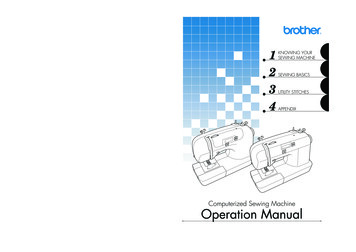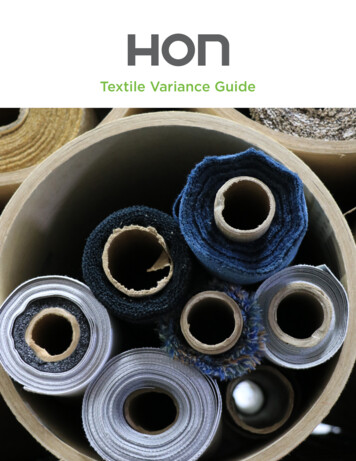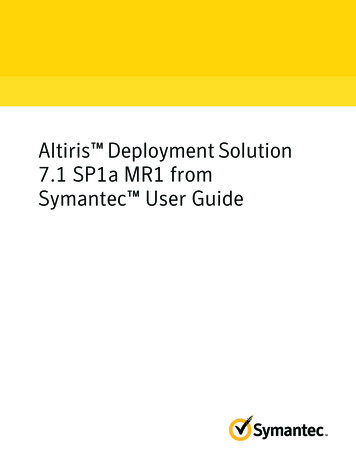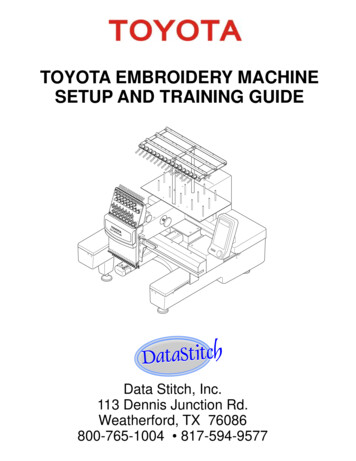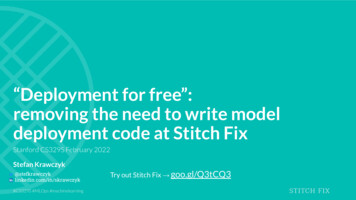
Transcription
“Deployment for free”:removing the need to write modeldeployment code at Stitch FixStanford CS329S February 2022Stefan 29S #MLOps #machinelearningTry out Stitch Fix goo.gl/Q3tCQ3
Stitch Fix“Deployment for free”Model Envelope & envelope mechanicsImpact of being on-callSummary & Future Work#CS329S #MLOps #machinelearning
Stitch Fix is a personal styling serviceKey points:1. Very algorithmically driven company2. Single DS Department: Algorithms (135 )3. “Full Stack Data Science”a.b.c.No reimplementation handoffEnd to end ownershipBuilt on top of data platform tools & abstractions.For more information: https://algorithms-tour.stitchfix.com/ & https://cultivating-algos.stitchfix.com/#CS329S #MLOps #machinelearning3
Where do I fit in?MSCS’10Pre-covid lookStefan KrawczykMgr. Data Platform - Model Lifecycle#CS329S #MLOps #machinelearningCheckout out our open source dataflow library that helpsmanage feature/workflow code for you: https://github.com/stitchfix/hamilton/4
Stitch Fix “Deployment for free”Model Envelope & envelope mechanicsImpact of being on-callSummary & Future Work#CS329S #MLOps #machinelearning
Typical Model Deployment Process #CS329S #MLOps #machinelearningMany ways to approach.Heavily impacts MLOps.6
Model Deployment at Stitch FixOnce a model is inan envelope.#CS329S #MLOps #machinelearningThis comes for free!7
Who owns what?DS Concerns#CS329S #MLOps #machinelearningPlatform ConcernsDS Concerns8
Deployments are “triggered”DS ConcernsPlatform ConcernsDS ConcernsGuess who is on-call?#CS329S #MLOps #machinelearning9
Reality: two steps to get a model to productionCan be a terminal point.Step 1Step 2Self-service: takes 1 hourNo code is written!#CS329S #MLOps #machinelearning10
Step 1. save a model via Model Envelope APIetl.pyimport model envelope as mefrom sklearn import linear modeldf X, df y load data somehow()model linear model.LogisticRegression(multi class 'auto')model.fit(df X, df y)my envelope me.save model(instance name 'my model instance name',instance description 'my model instance description',model model,query function 'predict',api input df X, api output df y,tags {'canonical name':'foo-bar'})Note: no deployment trigger in ETL code.#CS329S #MLOps #machinelearning11
Step 2a. deploy model as a microserviceGo to Model Envelope Registry UI:1) Create deployment configuration.2) Create Rule for auto deployment.a) Else query for model & hit deploy.3) Done.Result: Web service with API endpoints Comes with a Swagger UI & schema Model in production 1 hour.#CS329S #MLOps #machinelearning 12
Step 2b. deploy model as a batch taskCreate workflow configuration:1) Create batch inference task in workflow.a) Specify Rule & inputs outputs.2) Deploy workflow.3) Done.Result: Spark or Python task that creates a table. We keep an inference log. Model in production 1 hour.#CS329S #MLOps #machinelearning13
Stitch Fix“Deployment for free” Model Envelope & envelope mechanicsImpact of being on-callSummary & Future Work#CS329S #MLOps #machinelearning
Q: What is the Model Envelope? A: It’s a container.Enables treating the Enables thinkingmodelsas a “black box”.model aboutas a “blackbox” Powers MLOps features.#CS329S #MLOps #machinelearning15
Wait this feels familiar?You: “MLFlow/Verta much?”Me: Yes & No.This is all internal code -- nothing from open source.In terms of functionality we’re closer to a mix of: MLFlow Verta.ai ModelDB TFXBut this talk is too short to cover everything.#CS329S #MLOps #machinelearning16
Typical Model Envelope use1.call save model() right after model creation in an ETL.2.also have APIs to save metrics & hyperparameters, and retrieve envelopes.3.once in an information is immutable except:a.tags -- for curative purposes.b.metrics -- can add/adjust metrics.#CS329S #MLOps #machinelearning17
What does save model() do?12#CS329S #MLOps #machinelearning3418
What does save model() do?1Let’s dive deeper into these.2#CS329S #MLOps #machinelearning3419
How do we infer a Model API Schema?Goal: infer from code rather than explicit specification.Require either fully annotated functions with only python/typing standard types:def good predict function(self, x: float, y: List[int]) - List[float]:def predict needs examples function(self, x: pd.Dataframe, y):Or, example inputs that are inspected to get a schema from:my envelope me.save model(instance name 'my model instance name',instance description 'my model instance description',model model,query function 'predict',required for DF inputs api input df X, api output df y,tags {'canonical name':'foo-bar'})#CS329S #MLOps #machinelearning20
How do we infer a Model API Schema?Goal: infer from code rather than explicit specification.Require either fully annotated functions with only python/typing standard types:Why get a schema?def good predict function(self, x: float, y: List[int]) - List[float]: Required for any form of validation:E.g. did the model get passed the right inputs?def predict needs examples function(self, x: pd.Dataframe, y):Or, exampleinputsthisthat areinspected to get a schema from:Whyway? To avoid breakage when something is updated.my envelope me.save model(instance name 'my model instance name',instance description 'my model instance description',model model,query function 'predict',required for DF inputs api input df X, api output df y,tags {'canonical name':'foo-bar'})#CS329S #MLOps #machinelearning21
Model API Schema - Under the hood One of the most complex parts of the code base (90% test coverage!)We make heavy use of the typing inspect module & isinstance(). Key component to enable exercising models in different contexts. We create a schema similar to TFX.Enables code creation and input/output validation.Current limitations: no default values in functions.#CS329S #MLOps #machinelearning22
How do we capture python dependencies?import model envelope as mefrom sklearn import linear modeldf X, df y load data somehow()model linear model.LogisticRegression(multi class 'auto')model.fit(df X, df y)my envelope me.save model(instance name 'my model instance name',instance description 'my model instance description',model model,query function 'predict',api input df X, api output df y,tags {'canonical name':'foo-bar'})Point: no explicit passing of scikit-learn to save model().#CS329S #MLOps #machinelearning23
How do we capture python dependencies?import model envelope as mefrom sklearn import linear modelWhy auto capture dependencies?df X, df y load data somehow()model linear model.LogisticRegression(multi class 'auto')model.fit(df X, df y) Want to be able to reproduce & reuse models.my envelope Easyme.save model(instance name 'my model instance name',for the user to get wrong.instance description 'my model instance description',model model,query function 'predict',api input df X, api output df y,tags {'canonical name':'foo-bar'})Point: no explicit passing of scikit-learn to save model().#CS329S #MLOps #machinelearning24
How do we capture python dependencies?Assumption:We all run on the same* base linux environment in training & production.Store the following in the Model Envelope: Result of import sys; sys.version info Results of pip freeze Results of conda list --exportLocal python modules (not installable): Add modules as part of save model() call. We store them with the model bytes.#CS329S #MLOps #machinelearning25
How do we build the python deployment env.?Filter: hard coded list of dependencies to filter. E.g. jupyterhub. upkeep cheap; add/update every few months.#CS329S #MLOps #machinelearning26
Stitch Fix“Deployment for free”Model Envelope & envelope mechanics Impact of being on-callSummary & Future Work#CS329S #MLOps #machinelearning
Remember this split:DS ConcernsPlatform ConcernsDS ConcernsMy team is on-call for#CS329S #MLOps #machinelearning28
Impact of being on-callTwo truths: a pagerNo one wants to be paged.No one wants to be paged for a model they didn’t write!But, this incentivizes Platform to build out MLOps capabilities: Capture bad models before they’re deployed!Enable observability, monitoring, and alerting to speed up debugging.Luckily we have autonomy and freedom to do so!#CS329S #MLOps #machinelearning29
What can we change?DeploymentAPIAutomatic capture license to change: Model API schema Dependency capture Environment info: git, job, etc.Incentives for DS to additionally provide: Datasets for analysis Metrics Tags#CS329S #MLOps #machinelearningMLOps approaches to: Model validation Model deployment & rollback Model deployment vehicle: From logging, monitoring, alerting To architecture: microservice, or Ray, or? Dashboarding/UIs30
Overarching benefit1.Data Scientists get to focus more on modeling.a.2.more business wins.Platform focuses on MLOps:a.can be a rising tide that raises all boats!#CS329S #MLOps #machinelearning31
Stitch Fix“Deployment for free”Model Envelope & envelope mechanicsImpact of being on-call Summary & Future Work#CS329S #MLOps #machinelearning
Summary - “Deployment for free”We enable deployment for free by: Capturing a comprehensive model artifact we call the Model Envelope. The Model Envelope facilitates code & environment generation for model deployment. Platform owns the Model Envelope and is on-call for generated services & tasks.Business wins: Data Scientists get to focus more on modeling. Platform is incentivized to improve and iterate on MLOps practices.#CS329S #MLOps #machinelearning33
Future Work Better MLOps features: Observability, scalable data capture (e.g. whylogs), & alerting. Model Validation & CD patterns.“Models on Rails”: Target specific SLA requirements.Configuration driven model creation: Abstract away glue code required to train & save models.#CS329S #MLOps #machinelearning34
Thank you! We’re hiring! S329S #MLOps #machinelearningTry out Stitch Fix goo.gl/Q3tCQ3
How do we capture python dependencies? #CS329S #MLOps #machinelearning 25 Assumption: We all run on the same* base linux environment in training & production. Store the following in the Model Envelope: Result of import sys; sys.version_info Results of pip freeze Results of conda list --export Local python modules (not installable):



